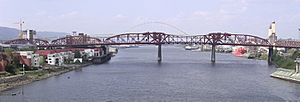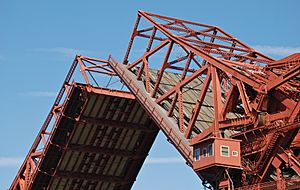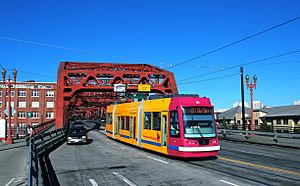Broadway Bridge (Portland, Oregon) facts for kids
Quick facts for kids Broadway Bridge |
|
|---|---|
 |
|
| Carries | Vehicles, Portland Streetcar and pedestrians |
| Crosses | Willamette River |
| Locale | Portland, Oregon |
| Maintained by | Multnomah County |
| ID number | 06757 |
| Characteristics | |
| Design | Truss with double-leaf Rall-type bascule lift span |
| Total length | 1,742 (531 m) |
| Width | 70 feet |
| Longest span | Fixed: 297 ft (91 m) Double-leaf bascule: 278 ft (85 m) |
| Clearance above | 13 feet (3.9 m) |
| Clearance below | 90 ft (27 m) at center (when bascule span is closed) |
| History | |
| Designer | Ralph Modjeski |
| Opened | April 22, 1913 |
|
Broadway Bridge
|
|
| Location | Portland, Oregon; Willamette River at river mile 11.7 |
| MPS | Willamette River Highway Bridges of Portland, Oregon |
| NRHP reference No. | 12000930 |
| Added to NRHP | November 14, 2012 |
The Broadway Bridge is a special kind of bascule bridge (a bridge that lifts up) that crosses the Willamette River in Portland, Oregon, USA. It was built in 1913. This bridge was the very first bascule bridge in Portland. It is still the longest bridge of its specific lifting design anywhere in the world! In November 2012, it was added to the National Register of Historic Places, which means it's an important historical landmark.
Contents
Building the Broadway Bridge
The people who planned the Broadway Bridge wanted it to be the longest lifting bridge in the world. Different companies had their own special designs for bascule bridges. The "Rall" design was chosen because it cost less money.
The famous engineer Ralph Modjeski designed the bridge. It opened on April 22, 1913. Building it cost about $1.6 million. At that time, it was the longest double-leaf bascule bridge of any type in the world.
The bridge gets its name from the street it carries, Broadway. When the bridge was built, the street was only called Broadway on the east side of the river. The west side of the street was called 7th Avenue. When the bridge opened and connected the two sides, the west side was renamed Broadway.
The bridge has four lanes for cars, two going each way. In 2006, about 30,000 vehicles crossed it every day. It's also a very popular route for bikes, with over 2,000 bike crossings daily in 2005. There are also two wide sidewalks, each about 11 feet (3.4 meters) wide. On average, the bridge's middle section lifts up about 25 times each month to let boats pass.
In 1927–28, a long ramp was built from the west side of the bridge. This ramp, called the Lovejoy Ramp, was about 2,000 feet (610 meters) long. It helped people get to and from the bridge because railroad tracks used to block the way.
The bridge was originally black, just like the nearby Steel and Hawthorne bridges. But in 1961, an architect named Lewis Crutcher suggested that each bridge should have its own special color. So, in 1963, the Broadway Bridge was repainted "Golden Gate" red. This color is also known as international orange.
Public Transportation on the Bridge
Streetcars used to cross the Broadway Bridge when it first opened in 1913. They stopped using the bridge in 1940, and the tracks were removed or covered up.
In 2010, work began to put new streetcar tracks back on the bridge. Streetcar service started again in 2012. The Broadway Bridge was also used by trolley buses from 1937 to 1958. Today, the Portland Streetcar's A Loop and B Loop lines use the bridge. One TriMet bus route, route 17-Broadway, also crosses the bridge.
Changes and Repairs Over Time
Because the Broadway Bridge is a complex structure, it has needed many repairs and updates over the years.
In 1948, the concrete road surface was replaced with a stronger steel grating. In 1982, the bridge was improved for bicyclists with new signals and sidewalk upgrades. From 2000 to 2001, the sidewalks and lighting were replaced to make it easier to use and save energy.
The long Lovejoy Ramp was removed in 1999. This was part of a big project to clear the old railroad area for new buildings. A much shorter Lovejoy ramp was built in its place, opening in May 2002.
A major renovation costing $28 million began in February 2003. During this work, the steel grating was replaced with a new, strong material called DuraSpan. This material is a fiber-reinforced polymer composite. The renovation was finished in February 2005.
In July 2010, the bridge was closed for two months. This allowed workers to start putting in new streetcar tracks and equipment for the expanded Portland Streetcar system. The bridge partly reopened in September. Streetcar construction continued through 2011, including installing the overhead power lines. The new streetcar line opened in September 2012. It was first called the CL Line, but in 2015, its name changed to A Loop and B Loop.
Gallery
Historic American Engineering Record Drawings
These are detailed drawings and descriptions from the Historic American Engineering Record (HAER), a program by the U.S. National Park Service.
Photographs














